Athenian Democracy › Empress Theodora › Viking Age Greenland » Origins and History
Articles and Definitions › Contents
- Athenian Democracy › Ancient History
- Empress Theodora › Who Was?
- Viking Age Greenland › Antique Origins
Ancient civilizations › Historical places, and their characters
Athenian Democracy › Ancient History
Definition and Origins

Athens in the 5th to 4th century BCE had an extraordinary system of government: democracy. Under this system, all male citizens had equal political rights, freedom of speech, and the opportunity to participate directly in the political arena. Further, not only did citizens participate in a direct democracy whereby they themselves made the decisions by which they lived, but they also actively served in the institutions that governed them, and so they directly controlled all parts of the political process.
ANCIENT SOURCES
Other city -states had, at one time or another, systems of democracy, notably Argos, Syracuse, Rhodes, and Erythrai. In addition, sometimes even oligarchic systems could involve a high degree of political equality, but the Athenian version, starting from c. 460 BCE and ending c. 320 BCE and involving all male citizens, was certainly the most developed.
THE WORD DEMOCRACY (DĒMOKRATIA) DERIVES FROM DĒMOS, WHICH REFERS TO THE ENTIRE CITIZEN BODY: THE PEOPLE.
The contemporary sources which describe the workings of democracy typically relate to Athens and include such texts as the Constitution of the Athenians from the School of Aristotle ; the works of the Greek historians Herodotus, Thucydides, and Xenophon ; texts of over 150 speeches by such figures as Demosthenes ; inscriptions in stone of decrees, laws, contracts, public honours and more; and Greek Comedy plays such as those by Aristophanes. Unfortunately, sources on the other democratic governments in ancient Greece are few and far between. This being the case, the following remarks on democracy are focussed on the Athenians.
THE ASSEMBLY & COUNCIL
The word democracy ( dēmokratia ) derives from dēmos, which refers to the entire citizen body, and kratos, meaning rule.Any male citizen could, then, participate in the main democratic body of Athens, the assembly ( ekklēsia ). In the 4th and 5th centuries BCE the male citizen population of Athens ranged from 30,000 to 60,000 depending on the period. The assembly met at least once a month, more likely two or three times, on the Pnyx hill in a dedicated space which could accommodate around 6000 citizens. Any citizen could speak to the assembly and vote on decisions by simply holding up their hands. The majority won the day and the decision was final. Nine presidents ( proedroi ), elected by lot and holding the office one time only, organised the proceedings and assessed the voting.
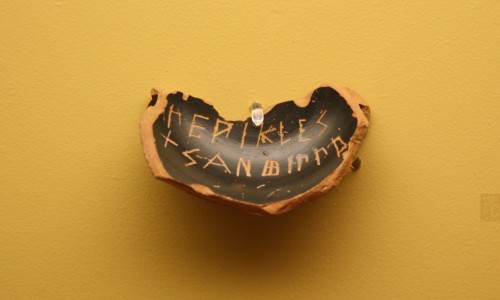
Ostrakon for Pericles
Specific issues discussed in the assembly included deciding military and financial magistracies, organising and maintaining food supplies, initiating legislation and political trials, deciding to send envoys, deciding whether or not to sign treaties, voting to raise or spend funds, and debating military matters. The assembly could also vote to ostracise from Athens any citizen who had become too powerful and dangerous for the polis. In this case there was a secret ballot where voters wrote a name on a piece of broken pottery ( ostrakon ). An important element in the debates was freedom of speech ( parrhēsia ) which became, perhaps, the citizen's most valued privilege. After suitable discussion, temporary or specific decrees ( psēphismata ) were adopted and laws ( nomoi ) defined. The assembly also ensured decisions were enforced and officials were carrying out their duties correctly.
There was in Athens (and also Elis, Tegea, and Thasos) a smaller body, the boulē, which decided or prioritised the topics which were discussed in the assembly. In addition, in times of crisis and war, this body could also take decisions without the assembly meeting. The boulē or council was composed of 500 citizens who were chosen by lot and who served for one year with the limitation that they could serve no more than two non-consecutive years. The boulē represented the 139 districts of Attica and acted as a kind of executive committee of the assembly. It was this body which supervised any administrative committees and officials on behalf of the assembly.
IT WAS IN THE COURTS THAT LAWS MADE BY THE ASSEMBLY COULD BE CHALLENGED & DECISIONS WERE MADE REGARDING OSTRACISM.
Then there was also an executive committee of the boulē which consisted of one tribe of the ten which participated in the boulē (ie, 50 citizens, known as prytaneis ) elected on a rotation basis, so each tribe composed the executive once each year.This executive of the executive had a chairman ( epistates ) who was chosen by lot each day. The 50-man prytany met in the building known as the Bouleuterion in the Athenian agora and safe-guarded the sacred treasuries.
In tandem with all these political institutions were the law courts ( dikasteria ) which were composed of 6,000 jurors and a body of chief magistrates ( archai ) chosen annually by lot. Indeed, there was a specially designed machine of coloured tokens ( kleroterion ) to ensure those selected were chosen randomly, a process magistrates had to go through twice. It was here in the courts that laws made by the assembly could be challenged and decisions were made regarding ostracism, naturalization, and remission of debt.

Kleroteria
This complex system was, no doubt, to ensure a suitable degree of checks and balances to any potential abuse of power, and to ensure each traditional region was equally represented and given equal powers. With people chosen at random to hold important positions and with terms of office strictly limited, it was difficult for any individual or small group to dominate or unduly influence the decision-making process either directly themselves or, because one never knew exactly who would be selected, indirectly by bribing those in power at any one time.
PARTICIPATION IN GOVERNMENT
As we have seen, only male citizens who were 18 years or over could speak (at least in theory) and vote in the assembly, whilst the positions such as magistrates and jurors were limited to those over 30 years of age. Therefore, women, slaves, and resident foreigners ( metoikoi ) were excluded from the political process.
The mass involvement of all male citizens and the expectation that they should participate actively in the running of the polis is clear in this quote from Thucydides:
We alone consider a citizen who does not partake in politics not only one who minds his own business but useless.
Illustrating the esteem in which democratic government was held, there was even a divine personification of the ideal of democracy, the goddess Demokratia. Direct involvement in the politics of the polis also meant that the Athenians developed a unique collective identity and probably too, a certain pride in their system, as shown in Pericles ' famous Funeral Oration for the Athenian dead in 431 BCE, the first year of the Peloponnesian War :
Athens' constitution is called a democracy because it respects the interests not of a minority but of the whole people. When it is a question of settling private disputes, everyone is equal before the law; when it is a question of putting one person before another in positions of public responsibility, what counts is not membership of a particular class, but the actual ability which the man possesses. No one, so long as he has it in him to be of service to the state, is kept in political obscurity because of poverty. (Thuc. 2.37)
Although active participation was encouraged, attendance in the assembly was paid for in certain periods, which was a measure to encourage citizens who lived far away and could not afford the time off to attend. This money was only to cover expenses though, as any attempt to profit from public positions was severely punished. Citizens probably accounted for 10-20% of the polis population, and of these it has been estimated that only 3,000 or so people actively participated in politics. Of this group, perhaps as few as 100 citizens - the wealthiest, most influential, and the best speakers - dominated the political arena both in front of the assembly and behind the scenes in private conspiratorial political meetings ( xynomosiai ) and groups ( hetaireiai ). These groups had to meet secretly because although there was freedom of speech, persistent criticism of individuals and institutions could lead to accusations of conspiring tyranny and so lead to ostracism.
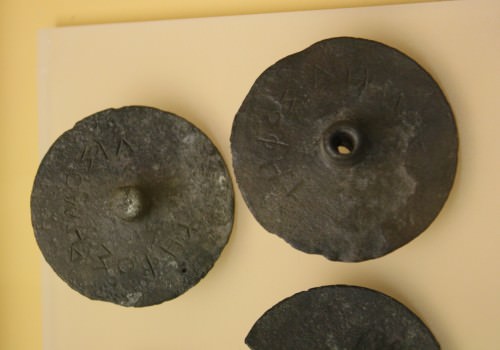
Greek Bronze Ballot Disks
Critics of democracy, such as Thucydides and Aristophanes, pointed out that not only were proceedings dominated by an elite, but that the dēmos could be too often swayed by a good orator or popular leaders (the demagogues), get carried away with their emotions, or lack the necessary knowledge to make informed decisions. Perhaps the most notoriously bad decisions taken by the Athenian dēmos were the execution of six generals after they had actually won the battle of Arginousai in 406 BCE and the death sentence given to the philosopher Socrates in 399 BCE.
CONCLUSION
Democracy, which had prevailed during Athens' Golden Age, was replaced by a system of oligarchy after the disastrous Athenian defeat in Sicily in 409 BCE. The constitutional change, according to Thucydides, seemed the only way to win much-needed support from Persia against the old enemy Sparta and, further, it was thought that the change would not be a permanent one. Nevertheless, democracy in a slightly altered form did eventually return to Athens and, in any case, the Athenians had already done enough in creating their political system to eventually influence subsequent civilizations two millennia later.
In the words of historian KA Raaflaub, democracy in ancient Athens was
a unique and truly revolutionary system that realized its basic principle to an unprecedented and quite extreme extent: no polis had ever dared to give all its citizens equal political rights, regardless of their descent, wealth, social standing, education, personal qualities, and any other factors that usually determined status in a community.
Ideals such as these would form the cornerstones of all democracies in the modern world. The ancient Greeks have provided us with fine art, breath-taking temples, timeless theatre, and some of the greatest philosophers, but it is democracy which is, perhaps, their greatest and most enduring legacy.
Empress Theodora › Who Was?
Definition and Origins
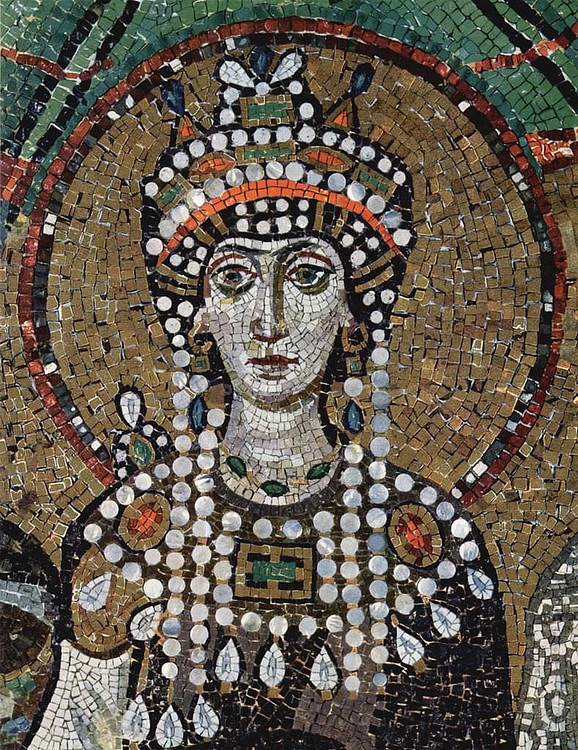
Theodora reigned as empress of the Byzantine Empire alongside her husband, Emperor Justinian I, from 527 CE until her death in 548 CE. Rising from a humble background and overcoming the prejudices of her somewhat disreputable early career as an actress, Theodora would marry Justinian (r. 527-565 CE) in 525 CE and they would rule together in a golden period of Byzantine history. Portrayed by contemporary writers as scheming, unprincipled, and immoral, the Empress, nevertheless, was also seen as a valuable support to the Emperor, and her direct involvement in state affairs made her one of the most powerful women ever seen in Byzantium.
EARLY LIFE
Theodora was born in c. 497 CE, the daughter of a bear-keeper called Akakios who worked for the Hippodrome of Constantinople. The 6th-century CE Byzantine historian Procopius of Caesarea states in his Secret History ( Anekdota ) that Theodora earned her living, like her mother before her, as an actress, which meant performing in the Hippodrome as an acrobat, dancer, and stripper. Theodora was said to have had one particularly lurid routine involving geese. By implication, considering the common association of the two professions at the time, she was also a courtesan. Procopius would have us believe an especially popular and lustful one, at that.
Procopius' Secret History, is, though, regarded by many as an outrageous gossip piece with a few facts thrown in for authenticity. The writer's attitude to both Justinian and Theodora is plainly that they were the worst thing ever to happen to the Byzantine Empire (in contrast to the official works he wrote under Justinian's patronage which are suitably laudatory of the emperor's achievements in war and architecture especially). Procopius also had it in for Antonina, the wife of Belisarius(Justinian's most talented general), and she is portrayed as constantly scheming with Theodora to create damaging palace intrigues. It is perhaps important to consider, too, that our knowledge of Theodora only comes from male authors and a woman performing any other role than the traditionally submissive one in Byzantine society was bound to be, at best, disapproved of and, at worst, outright demonised.
WITH THEIR LAVISH CORONATION IN THE HAGIA SOPHIA, JUSTINIAN & THEODORA SEEMED TO HERALD A NEW ERA FOR THE BYZANTINE EMPIRE & ITS PEOPLE.
Before she married Justinian, the nephew of Emperor Justin (r. 518-527 CE), in 525 CE, Theodora left the sands of the Hippodrome to travel to North Africa as the mistress of a medium-level civil servant. After the relationship broke up, she made her way back home via Alexandria where she may have converted to Christianity.
The marriage between such a lowly figure as Theodora and a future emperor was an odd rags-to-riches one, but there was a tradition in the Byzantine court for emperors to marry the winners of beauty contests organised for that purpose. The entrants to such contests could come from lower classes and from far away provinces so such mismatches were not unheard of. The lowly status of Theodora was not ignored by everyone, and one particularly passionate opponent was Empress Lupicina Euphemia, indeed, her death seems to have removed the foremost obstacle to the marriage. Justin I even went so far as to amend the laws (senators, which Justinian was, could not marry actresses) in order to permit the marriage and to legitimise Theodora's illegitimate daughter. Procopius also claims there was an illegitimate son, too, but no other sources substantiate this.
The Empress, 20 years younger than her husband, is described by Procopius as being short but attractive, a stickler for court ceremony, and a lover of luxury. Theodora was crowned as empress in the same coronation ceremony as her husband on 1 April 527 CE. Justinian had insisted his wife be crowned as his equal and not as his consort. The pair also matched each other in intelligence, ambition, and energy, and with their lavish coronation in the Hagia Sophia, they seemed to herald a new era for the Byzantine Empire and its people.
THE NIKA REVOLT
Theodora's active role in Byzantine politics and the staunch support she gave her husband are best revealed by the incident of the Nika Revolt of 11-19 January 532 CE. This was an infamous riot caused by factions of the supporters in the Hippodrome of Constantinople. The real causes for complaint were Justinian's tax hikes (to pay for his incessant military campaigns) and his general autocracy, but the riot was sparked by the emperor's refusal to pardon Blue and Green supporters for a recent outburst of violence in the Hippodrome.The troublemakers joined forces for once, and using the ominous chant “ Conquer !” ( Nika ), which they usually screamed at the particular charioteer they were supporting in a race, they organised themselves into an effective force.
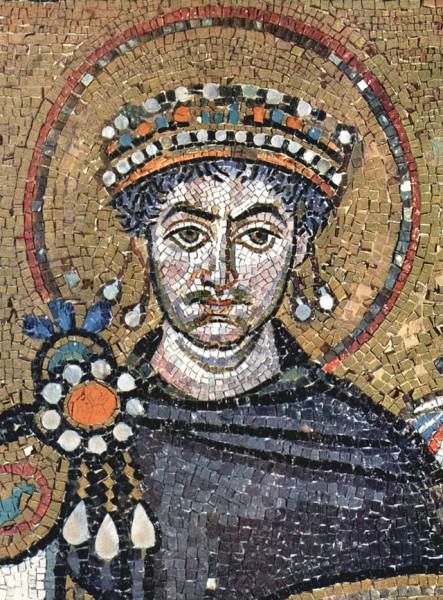
Justinian I
The trouble began with Justinian's appearance in the Hippodrome on the occasion of the opening races of the games. The crowd turned on their emperor, the races were abandoned and the rioters spilt out of the Hippodrome to rampage through the city. They left an impressive trail of destruction wherever they marched, burning down the Church of Hagia Sophia, the Church of Saint Irene, the baths of Zeuxippus, the Chalke gate, and a good portion of the Augustaion forum including, significantly, the Senate House. The starting point of all this destruction, the Hippodrome, escaped with only minor damage.The riot had become a full-scale rebellion and Hypatios, the general and nephew of Anastasius I (r. 491-518 CE), was crowned in the Hippodrome as the new emperor by the rioters.
Justinian was not to be so easily pushed from his throne, although it is Theodora who is credited with persuading the Emperor not to flee the mob but stand firm and fight. Her words at that crucial moment were recorded by Procopius as follows:
I do not care whether or not it is proper for a woman to give brave counsel to frightened men; but in moments of extreme danger, conscience is the only guide. Every man who is born into the light of day must sooner or later die; and how can an Emperor ever allow himself to become a fugitive? If you, my Lord, wish to save your skin, you will have no difficulty in doing so. We are rich, there is the sea, there too are our ships. But consider first whether, when you reach safety, you will not regret that you did not choose death in preference. As for me, I stand by the ancient saying: royalty makes the best shroud. (quoted in Brownworth, 79-80)
The imperial cause was greatly helped by the gifted generals Belisarius and Mundus, who ruthlessly quashed the revolt by slaughtering 30,000 of the perpetrators inside the Hippodrome. Hypatios, who had not actually wished to be crowned by the rioters, was executed nonetheless. No games were held in the Hippodrome for several years after the crisis, but one happy consequence of the whole destructive episode was the required rebuilding programme which resulted in the construction of the present version of the Hagia Sophia church.
ATTITUDE TO THE CHURCH
Theodora's religious policies seem to have been entirely her own, they were certainly not those of her husband, the leader of the Byzantine church and protector of orthodoxy. The Empress favoured Monophysitism, that is the belief that Jesus Christhad only one, divine nature ( physis ), which went against the orthodox view that he had two natures - one human and one divine. Nor were her views merely theoretical ponderings, for Theodora acted upon them and protected and housed priests and monks who adhered to monophysite beliefs, even using the Great Palace of Constantinople to do so. Indeed, the Empress is credited with the promotion of, and ultimately achieving the adoption of, Monophysitism in Nubia around 540 CE.
BESIDES THE DARKER TALES OF PERSONAL VENDETTAS & CRONYISM, THEODORA WAS NOTED FOR HER INFLUENCE ON JUSTINIAN'S SOCIAL REFORMS & HER CHARITABLE WORK.
POLITICAL INTRIGUES
Theodora's political manoeuvres are blamed for the downfall of the chief minister John of Cappadocia, although he was none too popular with the Byzantine people either because he was seen as the instigator of the oppressive tax reforms which had caused the Nika Revolt. Procopius, too, paints the finance minister as a paradigm of corruption and debauchery. John was dismissed after the revolt as one of the demands of the rioters but he later made a political comeback. It was then that Theodora was said to have conspired against him out of personal hatred. John was thus banished from court in 541 CE.
Other victims of the Empress' machinations were Pope Silverius (deposed in 537 CE) and possibly the Gothic queen Amalasuntha, who was assassinated, but real details and hard evidence are lacking. Belisarius was another who found himself in Theodora's bad books. He might have been a great general, perhaps Byzantium's greatest, but his success only aroused the suspicions of the empress, who may well have coloured her husband's dealings with his foremost commander, which resulted in a lack of material support in the field of battle when needed.
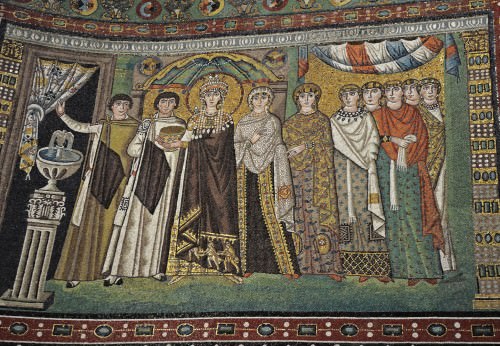
Empress Theodora & Her Court
Worse was to follow for Belisarius when the devastating bubonic plague struck the empire in the spring of 542 CE. Justinian himself was infected; he survived, but while he was gravely ill, Theodora ruled alone. Seeing that if her husband died, and with no heir to play regent for, her position would be untenable, the Empress moved quickly against the general she regarded as her greatest rival for the throne. Belisarius was too popular a figure to simply imprison or murder but he could be cut down a peg or two, and so Theodora ordered he be relieved of his command and his property be confiscated. Fortunately for the general, when Justinian recovered the following year and with the Moors and Goths baying at the frontiers of the empire, he was restored to his former position.
DEATH
Theodora died in 548 CE, aged just 51 or 52, probably of cancer. Justinian had no heir but, perhaps significantly, he never remarried. Theodora's daughter from before her marriage to Justinian had three sons and all of these became prominent figures in the Byzantine court. Justinian, after a period a deep mourning, would rule for another 17 years but he never seemed quite so focused or as brilliant as when he had had Theodora by his side.
Procopius might have stolen the accolades for most-lasting and colourful literary portrait of the Empress but, in the visual arts, there is a formidable rival to how Theodora is remembered in history. This most celebrated of depictions is in the church of San Vitale in Ravenna, Italy. The glittering wall mosaic shows the Empress in one panel while another shows Justinian and the archbishop of Ravenna, Maximian (r. 546-556 CE). Theodora, like her husband, is portrayed with a large halo. She is also wearing a great deal of jewellery with necklaces, earrings, and a fabulous gem-studded crown, and a Tyrian purple robe. She presents to the church a jewelled gold chalice and is surrounded by officials and her extensive entourage of court ladies.
Viking Age Greenland › Antique Origins
Ancient Civilizations
Greenland was drawn into the Viking Age and settled by Norse Vikings in the late 980s CE, their presence there lasting into the 15th century CE. Despite its ice-riddled geography, the Norse managed to carve out a living for themselves in these unforgiving lands by seeking out verdant pockets along the south-western coast, founding both the so-called Eastern Settlement (which is located, confusingly, in the south of West-Greenland) and the Western Settlement, some 650 km further north along the west coast in the present-day Nuuk region.
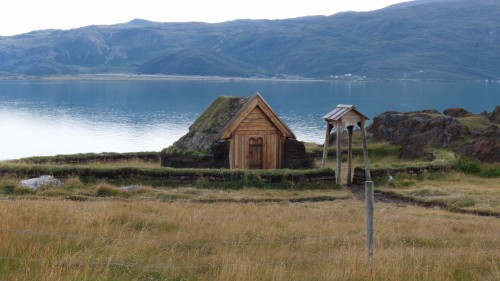
Reconstructed Church at BrattahlÃð, Greenland
Around 75% of Greenland's immense surface – which totals around 1,350,000 square km, making it the world's largest island – is covered by inland ice, which gangs up with slabs of drift ice floating along the coasts to make any sane person think twice about moving there just for fun. Glaciers and mountains function as natural boundaries, making inland travel far from straight-forward. With a mostly arctic climate boasting mean temperatures below 10 degrees Celsius in the warmest months with only some of its areas poking above this, Greenland is not exactly ideal for growing such staples as grain, and there are few trees.
To survive these conditions, the Norse combined stock farming – grazing livestock – with the hunting of such creatures as seals and caribou, while also undertaking hunting trips further north to the northern hunting grounds (at Nordsetur, Disko Bay) to hack down walruses, narwhals, and even polar bears. Viking Age Greenlandic society was anchored in the many farms that dotted the settlements, with Christianity visibly present in the churches accompanying them. These farms also directly exported precious goods such as skins, hides, and walrus ivory abroad while importing luxuries as well as the necessary iron.Competition kept power spread out among a whole group of elite farmers, and no governmental body was present, but Greenland did formally come under Norwegian sway in 1261 CE.
ERIK THE RED – FOUNDER OF NORSE GREENLAND - COINED THE NAME GREENLAND BECAUSE HE THOUGHT 'PEOPLE WOULD BE ATTRACTED TO GO THERE IF IT HAD A FAVOURABLE NAME.'
This course kept the Norse Greenlanders afloat until in the course of the 15th century CE a mysterious silence kicked in and any word of them stopped reaching beyond their island. Among other factors, the climate turning colder (by courtesy of the so-called Little Ice Age, c. 1300 - c. 1850 CE) is generally seen to have played a role in their disappearance. When in 1721 CE Norwegian missionary Hans Egede was the first to successfully navigate the drift ice since the silence and actually reach Greenland's former Western Settlement, he found Inuit there but no sign of the Norse.
DISCOVERY & INITIAL SETTLEMENT
With Iceland settled by Norse Vikings in the course of the 9th century CE, the North Atlantic was becoming familiar to them.Soon after, knowledge of new lands further west began to trickle in, first by way of Gunnbjörn Ulfsson whose ship was blown off course to within sighting range of Greenlandic islands (at an unknown date), and we know that in 978 CE, Snæbjörn Galti undertook an expedition in that direction, too, but that it turned into a disaster.
The first Viking to actually land on Greenland with his heart still beating – as far as we know – was Erik the Red. After being exiled from Iceland for murder around 982 CE, he skirted the southern tip of Greenland to land in what would become the Eastern Settlement ( Eystribyggð in Old Norse), in a fjord he confidently named Eriksfjord. He is the one credited with coining the name Greenland, according to The Saga of Erik the Red, because he thought that "people would be attracted to go there if it had a favourable name" (2, as found in The Sagas of Icelanders, 654). He went back to Iceland in 985 or 986 CE, hustling up people for a second expedition to Greenland. With several days of sailing in difficult conditions, it was a tough journey as the Landnámabók (Book of Settlements) states: "twenty-five ships sailed to Greenland from Breiðafjörð ur and Borgarfjörður, fourteen reached it, some were driven back and some were lost." The settlement had begun.
With its eastern shore a frozen wasteland, the appeal for the Norse was in Greenland's inner southwestern fjords and surrounding coastal lands, which are, in fact, green and liveable – even similar to Norway in terms of landscape, if not climate – with the right subsistence strategies and the right amount of stubbornness. As Iceland was getting a bit crowded for landowners, the vast wilderness of Greenland must have been appealing to those seeking to carve out their own holdings.
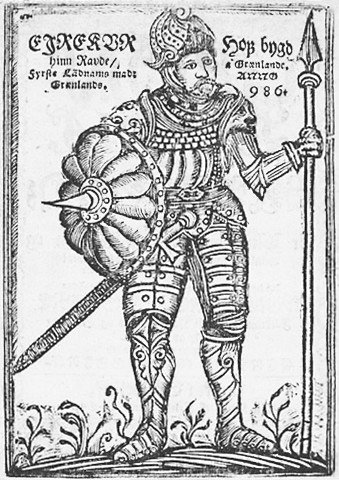
Erik the Red
The initial wave of Viking colonists was made up mostly of chieftains and rich farmers who owned their own ships and is thought to have numbered around 500 individuals. In an era known as the landtaking ( landnám ), they set up stock farms with the domestic animals they had brought along on their ships in the inner fjords where land was comparatively fertile. In the Western Settlement (Old Norse: Vestribyggð ), which was founded around the same time in what is now the Nuuk region further north along the west coast, the environment was a bit too hostile for a proper pasture economy but offered plenty of land as well as marine hunting, for instance in the shape of unsuspecting seals. It also became the launching pad for expeditions to North America ('Vinland'), where Leif Erikson, Erik the Red's son, founded a Viking settlement in Newfoundland.
FARMING
There is evidence for around 500 farms in the Eastern Settlement, whereas the Western Settlement counted maybe 100. These were not necessarily in a state of continuous operation; some were in use only periodically depending on the state of the vegetation. The Norse community in Greenland is estimated to have averaged around 1,400 people, with a peak of over 2,000 individuals around 1200 CE.
For these farms, it was all about location, with settlers looking for moraine plains close to the fjords as well as sheltered valleys with fertile land. Erik the Red, who obviously had first pick, built his farm at Brattahlíð (in the Eastern Settlement) in what is still an absolute prime farming location in Greenland, sitting snugly at the inner section of a fjord safeguarded from the outlying coastal fog and freezing waters. Higher elevations, by contrast, would have been easy prey to the elements, but one could still survive when focusing more on hunting.
THE NORSE GREENLANDIC ECONOMY WAS ROOTED IN A COMBINATION OF PASTORAL FARMING WITH HUNTING & FISHING, BOLSTERED BY THE EXPORT OF THE ARCTIC COMMODITIES OF SKINS, HIDES & IVORY.
Cattle, sheep, and goats – all shipped in – adjusted to Greenlandic conditions and were kept mostly for their milk and the subsequent cheese and butter, with sheep's wool coming in handy too. Although cattle had to be kept inside for many months, sheep and goats managed to survive outside. The farms were run in an infield-outfield system, with grazers chewing away at the outfields over the summer while the infields were manured or even irrigated in the growing season. Most of the meat came from hunted caribou and seals, although some of the larger farms also relied on their cattle herds.
After the more uniform settlement period, farms diversified: larger, high-status farms championed longhouses and the buildings were fairly scattered, while smaller farms were more centralised and kept their houses, cowsheds, stables and barns so closely huddled together one could move from one into the next without having to go outside – a response to climate change.The larger farms often also grabbed the better spots with the best yields, thus increasing their wealth, enabling them to keep prestigious but otherwise fairly useless cattle and cement their place in the elite with additions such as celebration halls and churches. Farms of all sizes seem to have been self-sufficient, though, making good use of hunting opportunities rather than relying solely on their livestock.
HUNTING & TRADE
The Norse Greenlandic economy was rooted in this combination of pastoral farming with hunting and also some fishing.Besides neighbourhood hunts and trips to the coast to hunt migratory seals in spring and autumn, both individual farms and groups of farmers banding together organised summer hunting trips way up north to Disko Bay where walruses, narwhals, and polar bears could be found. Here, they acquired precious skins, hides, and ivory. These were used in the local society itself to make garments and shoes but also as a form of currency, but they also formed the most important export commodities, as relayed by the 13th-century CE King's Mirror which describes Greenland's contact with the outside world around the start of the century:
Every item, with which they might help the country, they must buy from other countries, both iron and all the timber with which they build houses. People export these goods from there: goatskins, ox-hides, sealskins and the rope…which they cut out of the fish called walrus and which is called skin rope, and their tusks… ( King's Mirror 17)
The timber referred to was only used for building those parts of houses that could not be built in stone; especially in the later settlement, buildings were either purely made of stone or of stone and cut turfs. From what the Icelandic sagas tell us, it seems trade was a decentralised affair, with foreign traders landing near large farms, lodging there and trading directly with the locals, through whom the goods were then further distributed. This gave the large farms even more leverage, and there is evidence of payments being made to the biggest farms at, for instance, Gardar, Erik's Brattahlíð, and Sandnes. As such, a monetary economy never became a thing in Norse Greenland; controlling trade was the road to power.
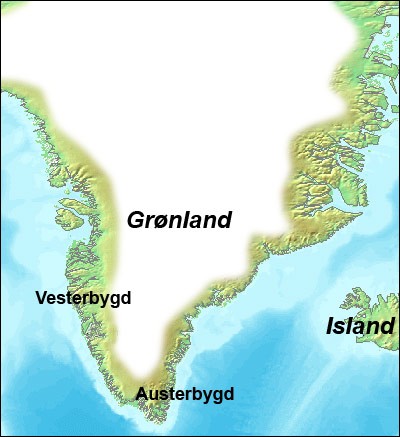
Viking Settlements in Greenland
Walrus ivory, in particular, did exceptionally well on the Northern European markets, and during the settlement period, Greenlanders would sail to Europe with their goods on their own private ships. However, when, from 1261 CE on, Greenland became subjected to Norway's power it was the Norwegian merchants who took over. At first, this ensured traffic continued between Norway and Greenland, but from the late 14th century CE onwards, the numbers of Norwegian ships sailing to Greenland dwindled heavily, only to cease entirely in the late 15th century CE.
THE CHURCH
The Norse settlements in Greenland appear to have been Christian basically from the get-go; not a single pagan grave has been unearthed, and there is evidence of churches that were built in the immediate settlement period. The Saga of Erik the Red bolsters the archaeological record in claiming that Leif Erikson was tasked by the Norwegian king Olaf Tryggvason (r. 995-1000 CE) with bringing Christianity to Greenland c. 1000 CE. Since Greenland was settled from Iceland, which became Christian by law in 1000 CE with conversions having picked up since Olaf Tryggvason's ascension to the Norwegian throne, it is hardly a stretch to assume the pioneering Norse sailing to Greenland would have ferried Christianity across the sea with them.
In later Greenlandic society, churches and burial grounds were always connected to farms, and it is assumed that even the first settling families might have adhered to this practice too. As in Iceland, churches were most likely privately owned by farmers, which would have given the owners an extra source of income. Over time, a shift can be seen from a multitude of small churches to fewer but larger churches, perhaps showing an increasing concentration of power in the hands of elite farmers.
Major parish churches have been found at Sandnes, undir Höfða, and Herjólfsnes, while a monastic church or convent stood at Narsarsuaq, but it was not until the 12th century CE that a bishop's see was established in Greenland, at Gardar, where a cathedral church was constructed on what was already the biggest farm on the island. This was a result of Norwegians poking their noses into Greenlandic business, and as far as the written sources tell us, the bishopric was only ever held by outsiders.
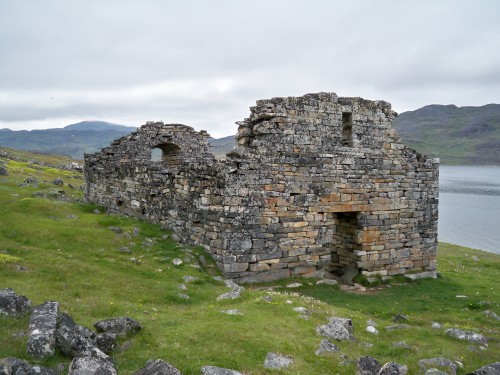
Hvalsey Church, Greenland
Probably hindered by the aggressively middle-of-nowhere location and the pesky amount of privately owned churches, the Roman Church struggled to gain much influence in Greenland throughout the settlement period in particular. In Iceland, where there were some similarities to the situation, the established church amped up the pressure in the 13th century CE, but Greenland's fate in this matter remains mysterious.
CONTACT WITH THE DORSET & THULE CULTURES
Of course, the Norse were not the only one people both stubborn and skilled enough to adapt to Greenland's decidedly special conditions; already in the 8th century CE the late Dorset Palaeo Eskimos had made their way to the Greenlandic side of the Nares Strait/Smith Sound region which lies between Greenland and Canada's Ellesmere Island. Around 1200 CE, the Thule culture people (the ancestors of the Inuit) joined in too, trekking from Alaska through Canada to Greenland and meeting the Dorset people in the Smith Sound region between c. 1200-1300 CE. The Dorset culture was in decline at this point and was replaced by the surging Thule culture.
During this time, the Norse undertook expeditions to the northern hunting grounds, too, and may have bumped into both of these cultures, as Jette Arneborg explains:
Archaeological finds and written sources indicate some interaction between the Dorset, Thule and Norse people;the nature of the contacts is however hardly known, but written sources indicate Norse interest in the skrælings [an Old Norse term for these peoples] and one explanation could be the exchange of commodities. The Norse may have acquired walrus ivory from the Palaeo Eskimo and Inuit hunters in return for metals. The majority of Norse finds found in Thule culture context are metals. ( Viking World, 594)
Artefacts from these cultures have been found in Viking contexts, and vice versa, which probably indicates they traded with each other, but to what extent is hard to figure out. It seems the commodities acquired from the Dorset and Thule cultures did well abroad and were mostly exported by the Vikings.
The Thule people expanded further across Greenland, reaching the Scoresby Sound on the east coast by c. 1300 CE and subsequently scooting further south and southwest later in the 14th century. The Vikings' Western Settlement was reached by the mid-14th century, roughly coinciding with the last signs of the Norse in that region; this would later spark theories of the Thule people having had a hand in the Norse's demise, but this has by now been dismissed. The Thule people also came close to the Eastern Settlement around this time, possibly living along the outer coastal area of the region while the Norse occupied the inner fjords, but only for a generation or two.
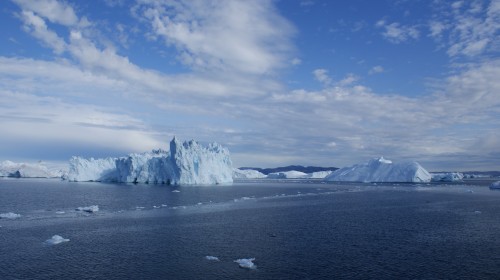
Disko Bay, Greenland
MYSTERIOUS DEMISE
During the 14th and 15th centuries CE, something went terribly wrong for the Norse Greenlanders. The last written evidence we have of them stems from 1424 CE when a Greenlandic priest wrote a letter in which he verified to have been present at the wedding of a young couple in Hvalsey fjord (in the Eastern Settlement) in 1408 CE, after which a deafening silence sets in. Remains of burials show signs of life until around 1450 CE for the Eastern Settlement, while the written- and the archaeological record suggests the Western Settlement collapsed into ghost -town status already a century before, in the mid-14th century CE.
Around this time, the drift ice around Greenland had become so fiercely annoying that no one succeeded in reaching the island until the Norwegian missionary Hans Egede made land at the former Western Settlement in 1721 CE. Here, he found only Inuit and no Norsemen. Early theories to explain their disappearance revolved around imagined conflict with the Inuit, Greenland's isolation from the perceived safety blanket that was Europe, and even inbreeding supposedly ruining the originally fine physical specimens that were the Vikings, but have since been discarded for lack of evidence.
Cue the climate change argument, which became the most long-lived single explanation and ascribes the Little Ice Age which affected Greenland from the 14th century CE (until c. 1850 CE) the touch of death. Glaciers expanded, temperatures dropped, and the wind picked up, which, considering the already overexploited state of vegetation, helped lead to erosion while rising sea levels also nibbled away precious grassland. Sea ice would also have lunged in and out of Greenland's shores, affecting both trade and hunting. Even in the snugly sheltered fjords of southern Greenland which are normally boosted by warm sea currents, the effect was felt. Skeletons show the Norse were directly impacted by this change in climate and a shift to a more marine diet is visible, too. Overall, the Little Ice Age must have had a fair impact on the Norse Greenlanders.
However, the story cannot have been that simple; the Little Ice Age was not a state of constant refrigeration but came in waves, and the Inuit were fine throughout all of it, indicating culture could make a difference, here, too. Unlike the Norse, the Inuit also hunted ring seals through breathing holes in the winter ice using their advanced harpoon-hunting technology and made use of larger parts of Greenland than did the Norse, who remained dependent on their farms and pastures. These were, of course, more vulnerable to cold snaps, and the archaeological record shows that the occupants of at least some farms died or starved rather than emigrating. Some may have emigrated, though, with more lands being available in Europe in general due to depopulation (some of it thanks to the plague in 1348 CE, which probably at least indirectly affected Greenland too by falling export prices and maybe even directly). Scholars agree, though, that rather than one single perpetrator, the Viking Age in Greenland must have ended through a combination of factors such as these.
LICENSE:
Article based on information obtained from these sources:with permission from the Website Ancient History Encyclopedia
Content is available under License Creative Commons: Attribution-NonCommercial-ShareAlike 3.0 Unported. CC-BY-NC-SA License